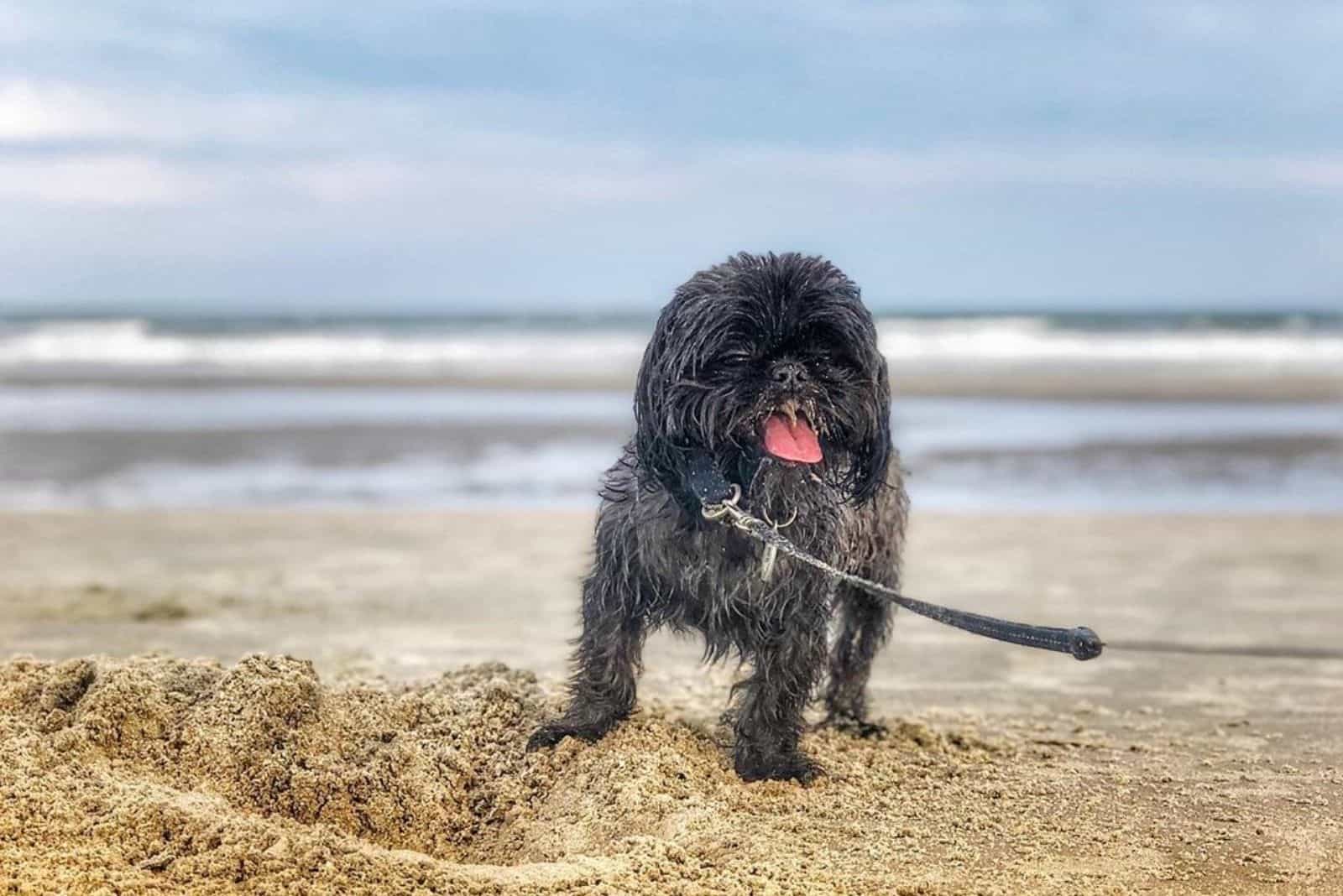The Shih Tzu is one of few dog breeds that come in a wide array of colors and about a dozen markings. This, together with their adorable appearance, makes them one of the most loved canines.
However, this huge number of coat colors can come with a catch. It isn’t uncommon for a dog owner to not be certain what color their Shih Tzu truly is.
This is because a lot of puppies appear to have a different color than the one they were registered under within a kennel club. The owner might find that their dog is listed under a color that doesn’t match reality.
Not just that, but many Shih Tzus will experience color changes, making everything even more complicated. It’s no wonder all of this can make anyone confused!
One of the colors that really fascinates everyone is the silver Shih Tzu. And it’s no surprise – this is probably one of the more unique Shih Tzu coat colors!
So, what makes a silver Shih Tzu so unique? We’ll explain this and give you more information on other Shih Tzu colors, both recognized and unofficial.
Shih Tzu Coat Colors
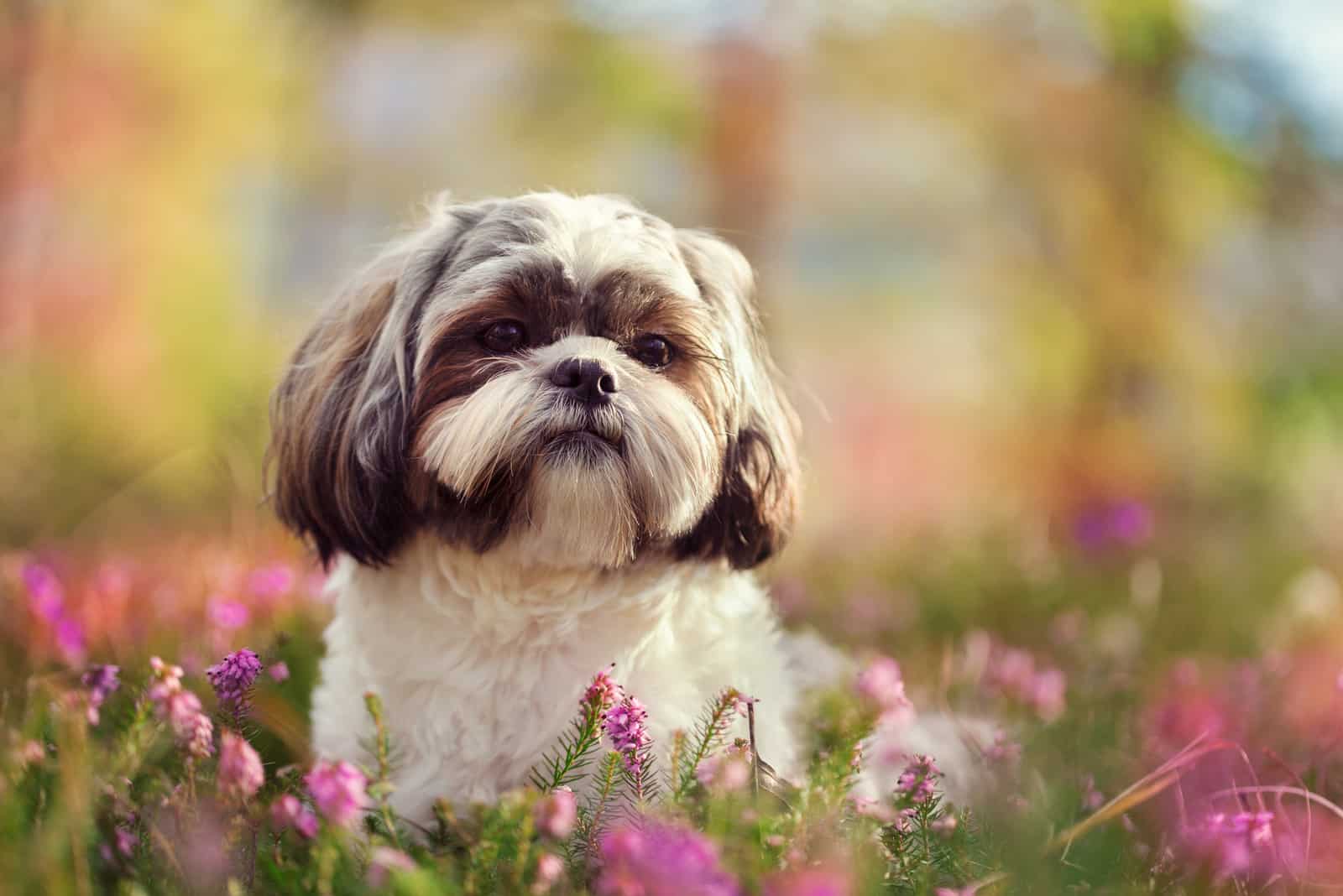
As mentioned before, Shih Tzus come in a huge variety of coat colors. However, not all are permissible in all kennel clubs. Let’s look a bit deeper.
According to the American Kennel Club (AKC), all Shih Tzu coat colors are allowed. However, you might have to list a dog of some color under a color name that may not be what you’re seeing.
We’ll explain in a moment.
The United Kennel Club (UKC) and Fédération Cynologique Internationale (FCI) agree with the AKC, adding that dogs with a white tip to their tail and a white blaze on their forehead are especially desirable in parti colors.
According to the Canadian Kennel Club, while all colors are acceptable, all dogs must have black noses, lips, and eye rims.
So, if all coat colors are allowed, where’s the catch?
When they are born, Shih Tzu puppies can have either a solid coat color, a two-color combination, or they can even be a mix of three colors spread in various patterns. However, these colors can change over time, and in a matter of months, your dog might not look the same as when you got him.
Not just that, but some kennel clubs, such as the AKC, register dogs based on their skin color or even nose color instead of coat color! All of this can complicate your understanding of Shih Tzu colors.
So, What’s The Difference Between Official And Unofficial Coat Colors?
While all coat colors are official, you may come across breeders that have different names for their puppies’ colors. Many of these names aren’t recognized by kennel clubs, even though the coat colors are.
There are several reasons why breeders might use these names instead of the official ones. Some might want to better describe the particular shade of the pup’s fur. Most of the time, however, they want their puppies to have unique names so that they can raise prices.
If you encounter dogs with fancy-sounding coat color names, chances are, this is the case. Some of the said names include Isabella, lavender, or chocolate. According to most kennel clubs, these dogs would be labeled as ‘liver,’ although they might not look like standard liver dogs.
If you’re looking for silver Shih Tzus, you’ll be glad to hear that they are among the accepted colors.
Do Shih Tzus Change Colors?
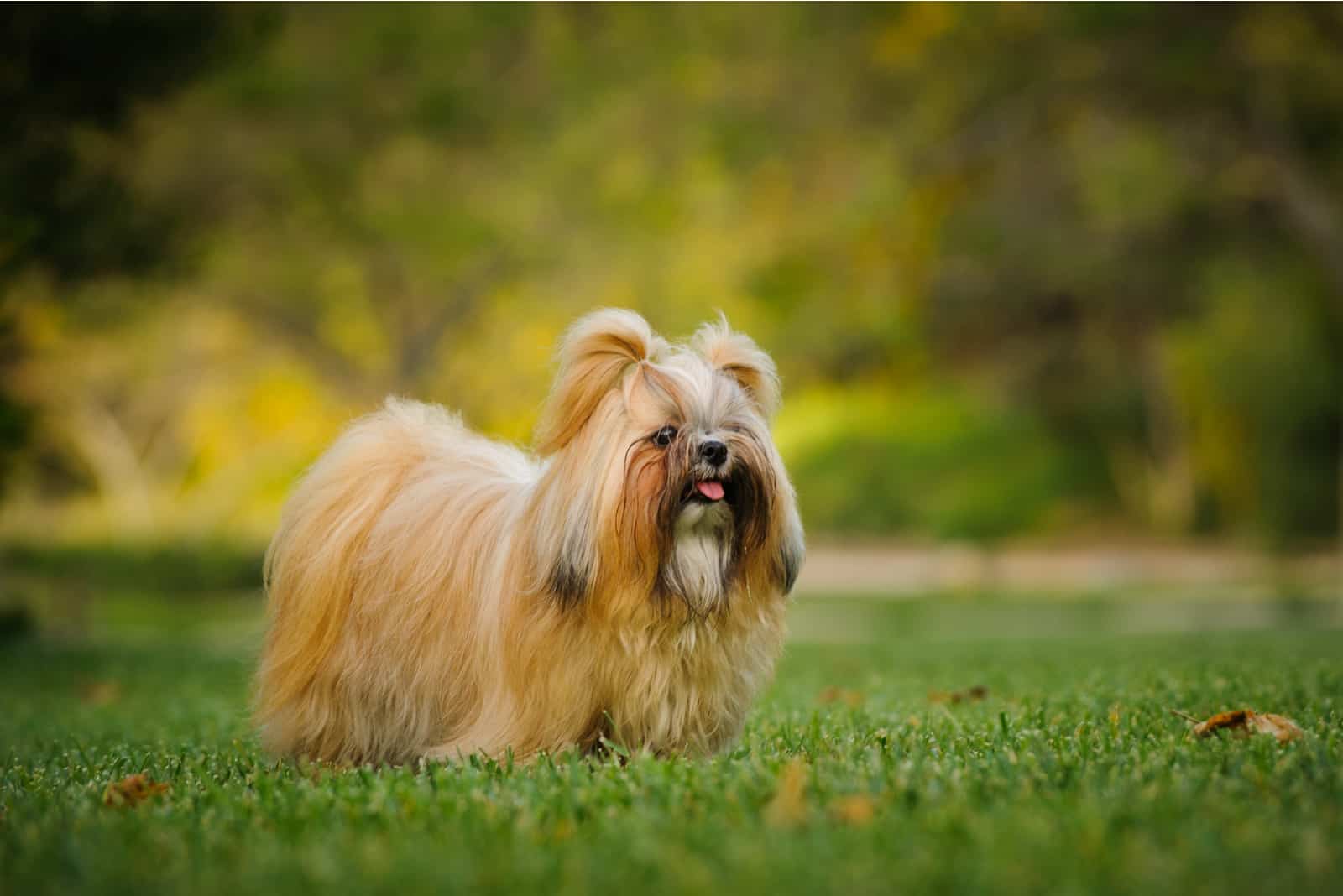
One of the reasons choosing a silver Shih Tzu – or a Shih Tzu of any particular color – might be a bit complicated is because Shih Tzus experience significant color change over time. In fact, chances are, your Shih Tzu will look like an entirely different dog before they are one year old!
For example, most silver Shih Tzus are born black, but their color lightens as the years go by.
This color change occurs due to genetics. Not one but two genes determine what will happen to the Shih Tzus’ colors over time and his final coat color.
First, there is the ‘G’ gene. This gene causes fading, or ‘graying,’ as the dog gets older. Most of the time, the fading will start before a Shih Tzu puppy is one month old, and this will continue for a year – sometimes longer!
On the other hand, there is the Chinchilla gene (CH series). This gene turns dogs into a rich, silver color instead of dulling the shade. Yes, this gene is responsible for the existence of the adorable silver Shih Tzu.
All Shih Tzu colors are equally prone to color changing, but this might be more noticeable on darker colors, as the change will be drastic. Some lighter dogs might turn gray, or they might appear as if their color hasn’t changed.
Some experts and breeders think that environmental factors can also affect the color change. This includes things such as stress, climate, and even diet. In the end, if you give your dog food that is bad for him, such as spicy things, you cannot expect his coat to stay a healthy color!
However, these claims are still to be proven, and there is no definite evidence that these things truly affect the coat color – but they surely affect the coat quality.
Silver Shih Tzu
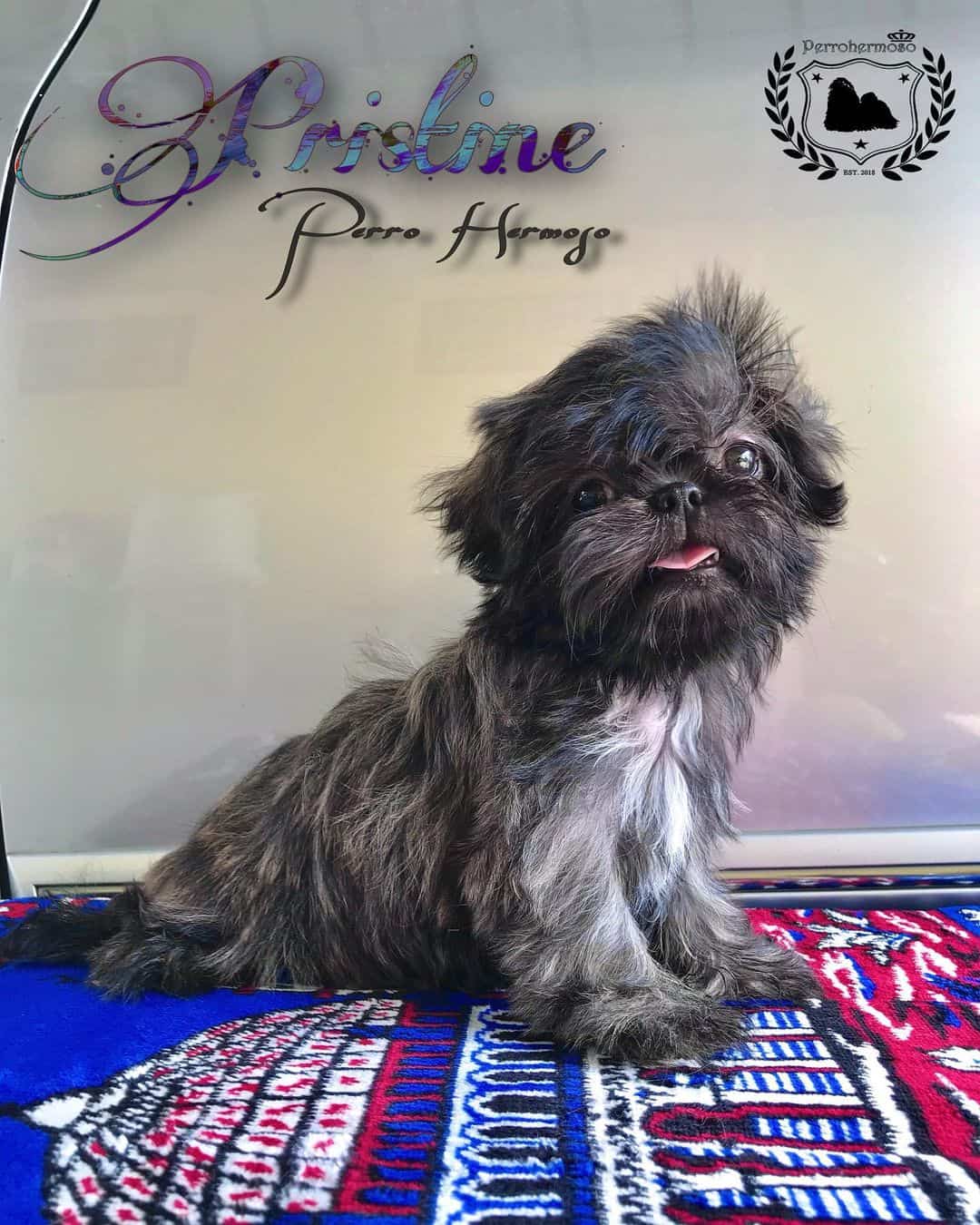
Photo from: @fonchoy_11
Silver Shih Tzus are considered to be one of the prettiest dogs of this breed. While some dog lovers confuse them with grey Shih Tzus, the silver coat has a pretty shine to it. It can be lighter or darker in color, but it will always look glossy and stylish.
While solid-colored Shih Tzus are rare, there are still dogs in this color. Most, however, have at least a few markings on their coat – most notably, white. However, other color combinations are also possible, and we’ll go through them.
Silver isn’t an overly rare color in Shih Tzus, but it’s still very sought-after and prized. This is because of how beautiful and unique it is, and not many other dog breeds can be truly silver like Shih Tzus can.
A silver Shih Tzu will always have black lips, black foot pads, eye rims, as well as a black nose. These are the main features that make it stand out from a blue Shih Tzu that has a blue or grey nose.
Silver Shih Tzu Puppies
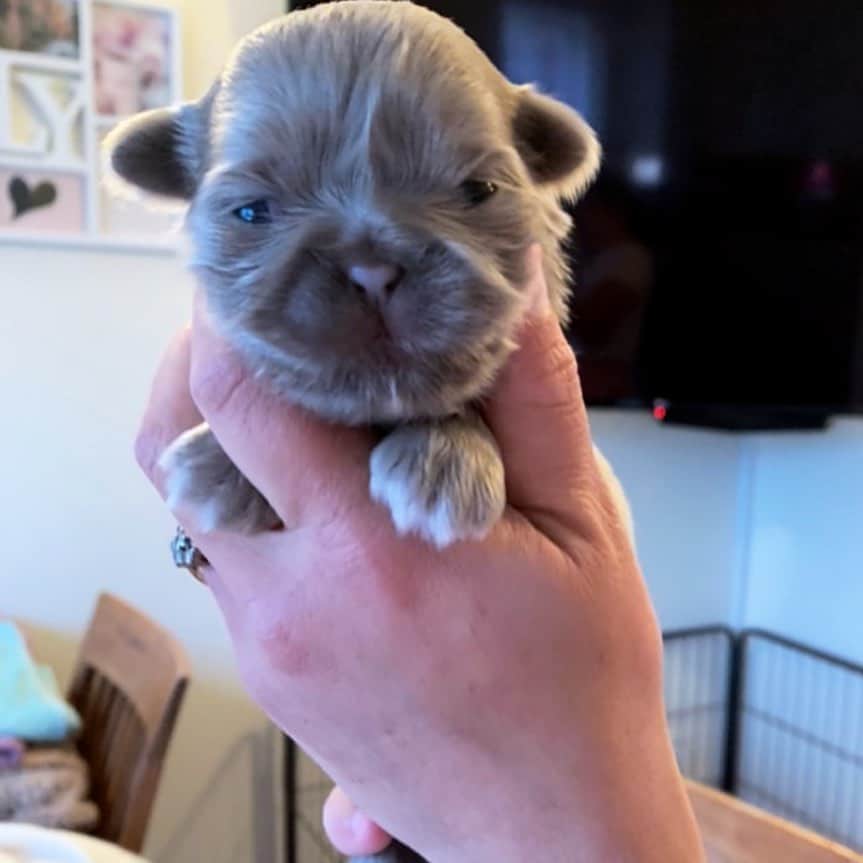
Photo from: @sunshineshihtzu
Just like many other Shih Tzu colors, silver Shih Tzus are born much darker. Many will appear to be pure black or black and white. Over time, their color will fade until it becomes a gorgeous silver shade.
As mentioned before, this color change occurs because of the Chinchilla gene, something present in every silver Shih Tzu. It causes dark-haired puppies to become this gorgeous, silky color that stands out from the rest.
Because of this Chinchilla gene, these pups don’t look the same as grey Shih Tzus, and their color change occurs in a different way. Still, silver Shih Tzu puppies will likely look the same as grey or blue Shih Tzus when they are born.
This does make things a bit more complicated for breeders and buyers alike, as they cannot be certain what their Shih Tzus will look like in adulthood.
Silver Shih Tzu Patterns And Color Combinations
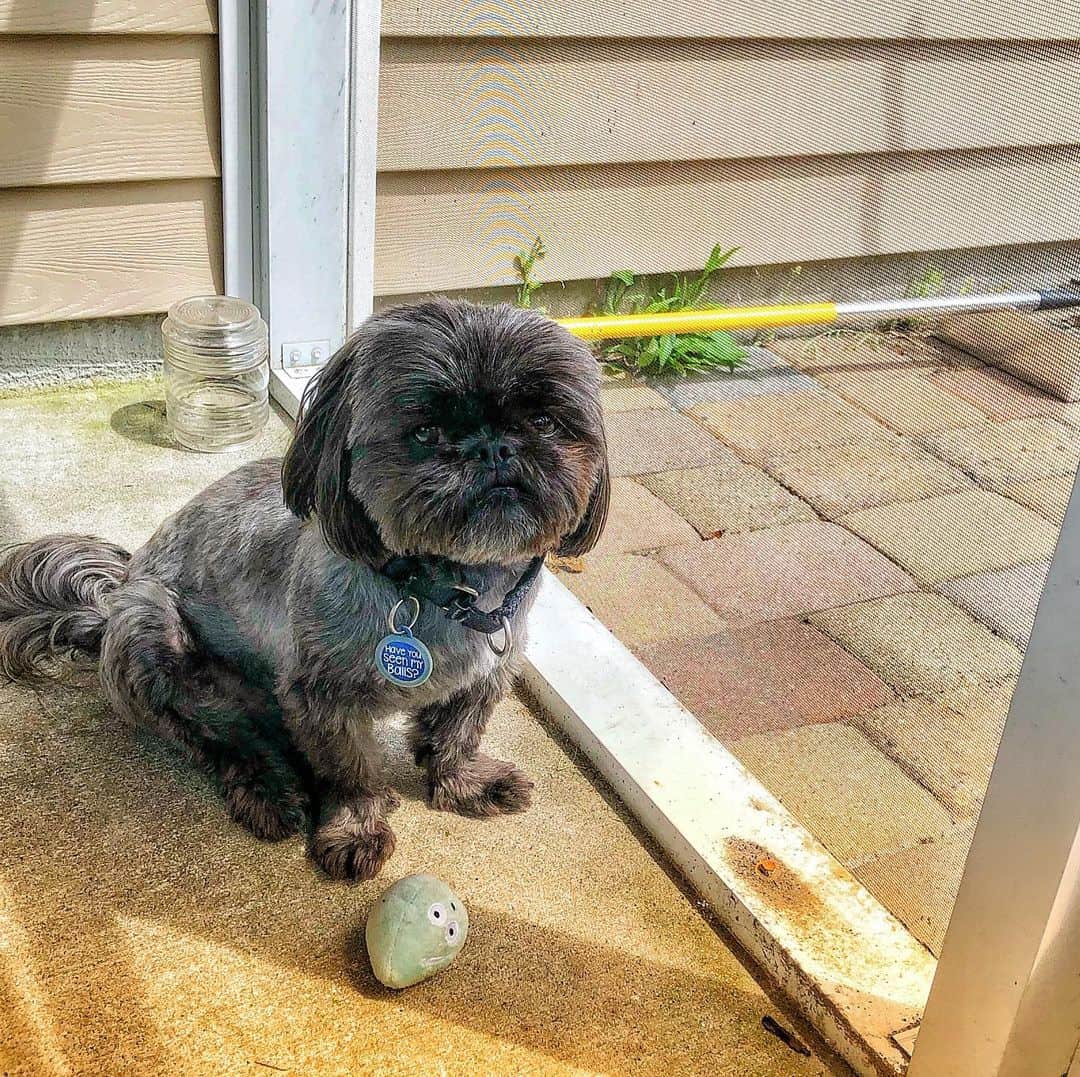
Photo from: @stormyshihtzu
Now that you know how a silver Shih Tzu looks in a solid color, it’s time to explore some patterns these dogs can come in.
As mentioned before, silver Shih Tzus usually come with some markings or patterns. While the most common a is silver and white Shih Tzu, we’ll go over most other possibilities.
Once again, it’s worth noting that all Shih Tzu colors are approved by major kennel clubs, so no matter what color Shih Tzu you’ve got, you will be able to register them.
Without further ado, here are some of the common silver Shih Tzu color combinations and patterns:
Silver And White Shih Tzu
Silver and white is likely the most common silver Shih Tzu color combination. These dogs have a silver base coat with white markings.
These white patches can come in any pattern. Most of the time, the Shih Tzu’s muzzle, chest, stomach, and paws will be white, but any part of your pooch’s body can be white.
Keep in mind that most of the dog’s body has to be silver for a Shih Tzu to be considered silver and white.
Silver Brindle Shih Tzu
Brindle is a pattern expressed by dark, tiger-like stripes on a base coat color. These stripes can be wide or narrow, and they can cover an entire coat or just a portion of it.
Brindle Shih Tzus are very rare, as brindle is a pattern caused by a recessive gene. In other words, both parents have to carry a brindle gene (although they don’t have to be brindle themselves) to get a brindle puppy.
The combination of a silver and brindle coat is quite rare, but it can occur. Unless a dog is tri-colored, meaning that a portion of a silver Shih Tzu’s coat is covered with brindle stripes.
Silver Parti Shih Tzu
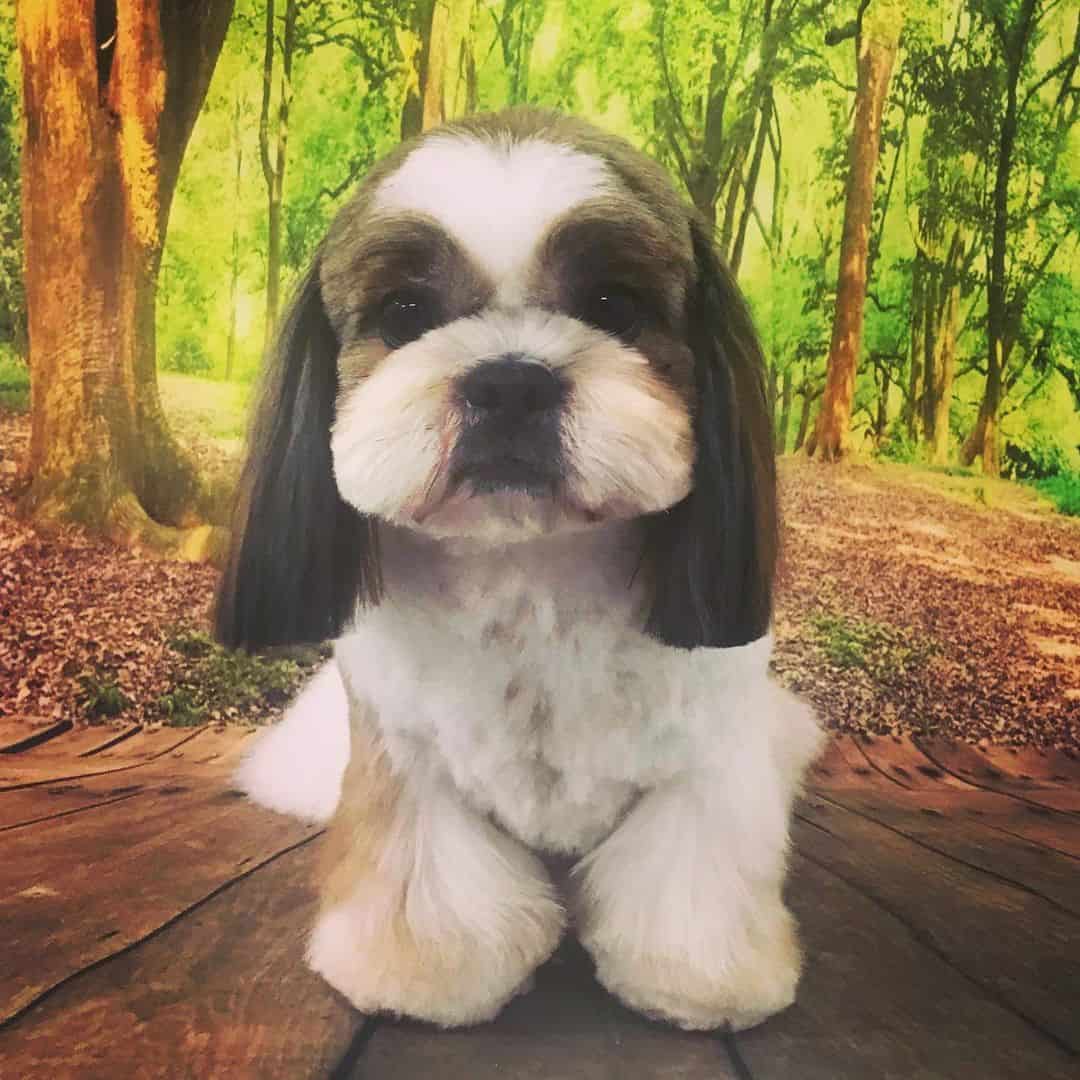
Photo from: @groomed.with.lauren
Parti Shih Tzus have large spots on their coats. This pattern usually means a dog is two-colored, although tri-color combinations are also possible.
Most silver parti Shih Tzus have white spots on a silver coat. However, other color combinations can also occur.
Black And Silver Shih Tzu
Black and silver Shih Tzus are similar to black and grey Shih Tzus, and many people can get them confused. These are black dogs with grey markings. However, the markings are shiny and silky compared to a duller grey color.
Since the first color in the shade name is the base color, these dogs have a black base color, and only a smaller portion of their body is silver. If it’s the opposite, they’d be known as silver and black Shih Tzus.
Keep in mind that most black and silver Shih Tzus will look just like solid black dogs when they are born. As they grow older, however, the silver markings will become more apparent. Most of the time, you can notice the silver area when they are just a few weeks old.
White And Silver Shih Tzu
White and silver Shih Tzu dogs look similar to silver and white Shih Tzus. The biggest difference is that the base color of these dogs is white, while the spots and markings are silver.
Other than that, there is no significant difference between these dogs and silver and white Shih Tzus.
Blue Silver Shih Tzu
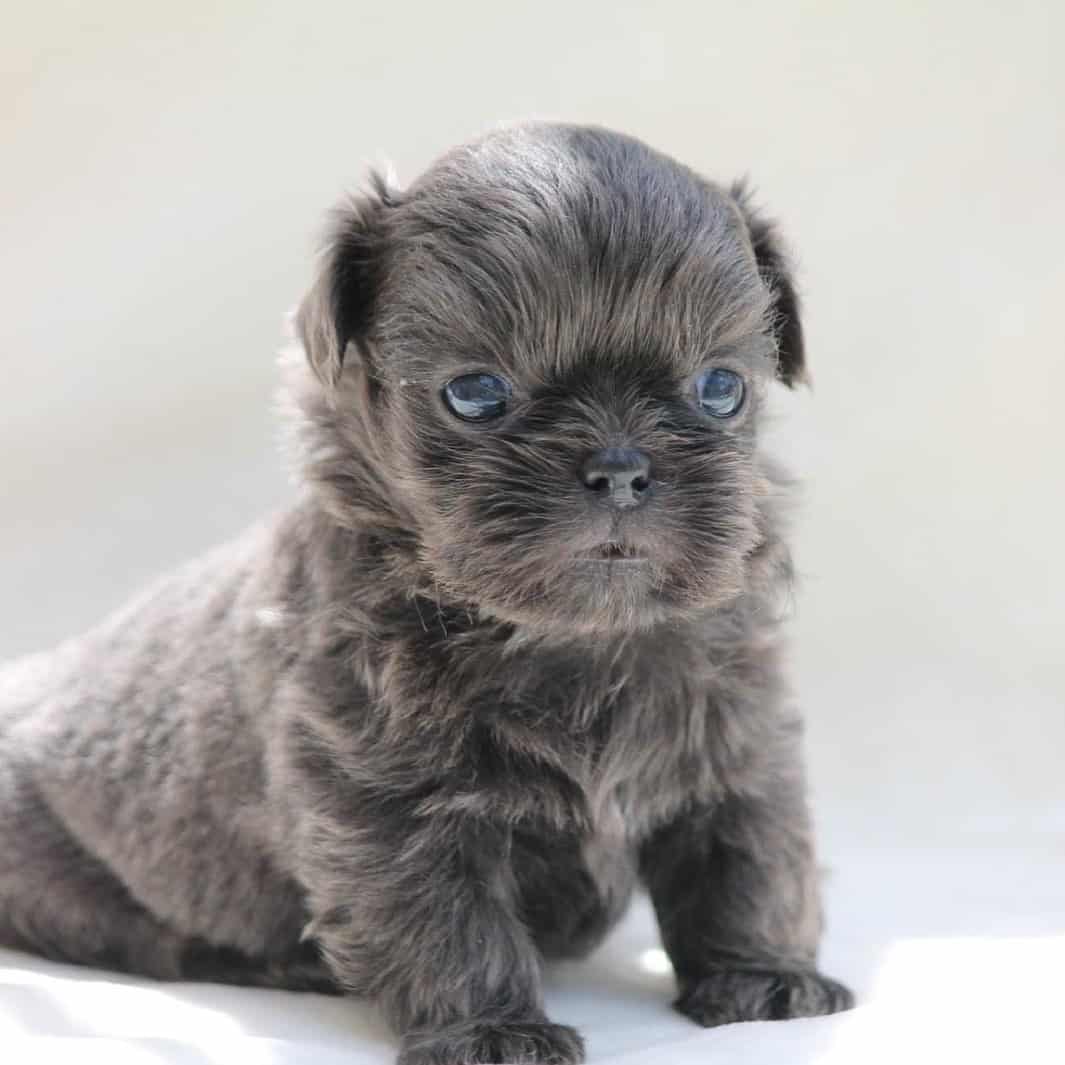
Photo from: @simply_ds_aussies_
The blue silver Shih Tzu is a dog that can be tricky to find.
Unlike most other silver Shih Tzu combinations, these dogs have blue noses. This is because blue Shih Tzus aren’t determined by the color of their coat, but rather, skin – but more on that later on.
The coat of the blue silver Shih Tzu can have larger or smaller areas of a silver coat. This doesn’t really matter for the classification. There may even be a third color present, such as white or black.
However, the dog’s nose, paw pads, eye rims, and lips will always stay blue.
Black Gold Silver Shih Tzu
The black gold silver Shih Tzu is a rare color combination in silver Shih Tzus. These are tricolor dogs that usually come in a silver and gold pattern but with a black mask and black ears.
Sometimes, more black markings can be present; however, these are the most prevalent and common ones.
Keep in mind that it is almost impossible to find a dog with a black base and gold and silver markings – but it can still happen.
No matter the pattern, just like most other silver Shih Tzus, the black gold silver Shih Tzu will always have a black nose.
Silver Shih Tzu For Sale
When looking for a silver Shih Tzu for sale, you don’t really have to find a breeder who is qualified in breeding silver Shih Tzus. These dogs are bred just like any other Shih Tzu color.
However, you should always look for a reputable breeder for many other reasons, such as your dog’s health and behavior.
If you’re wondering about the price of silver Shih Tzus, you should know that they don’t cost much more than regular Shih Tzus would. The average price range for the breed is $500–$1,500, and you can expect a silver Shih Tzu to be closer to the upper price.
Other Shih Tzu Colors
Since you’re already here, we feel like we should introduce you to other Shih Tzu colors.
If you want to purchase one of these dogs, you can expect them to come in any of the following colors and patterns:
Black Shih Tzu
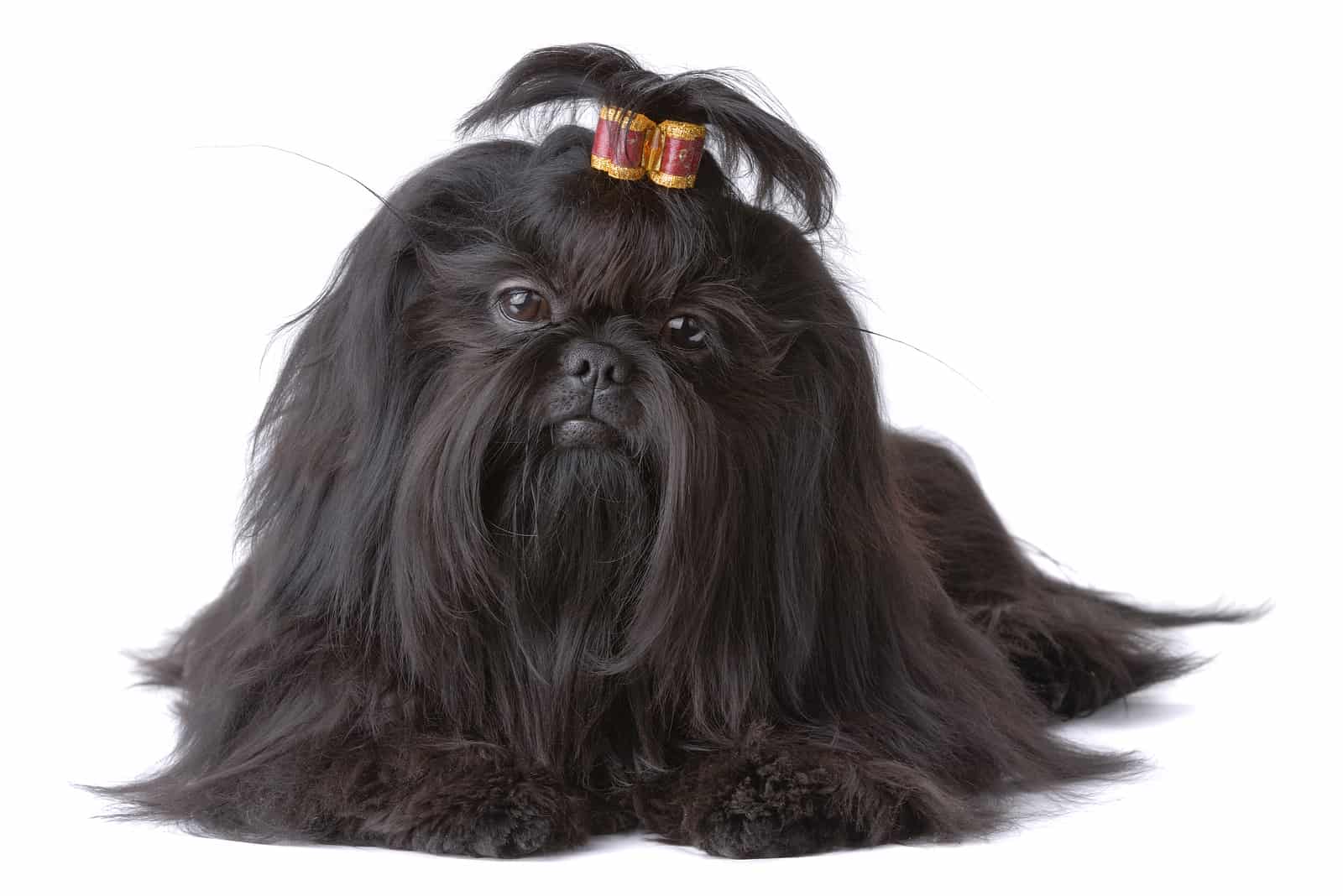
While a dominant color, true black Shih Tzus are rare. These dogs are solid black, without even a hair of some other color. If this happens, a dog will be considered a combination.
Also, since black is a dominant gene, black Shih Tzus will always have a black nose, foot pads, eye rims, and lips. You cannot find a black Shih Tzu with, for example, a brown nose.
White Shih Tzu
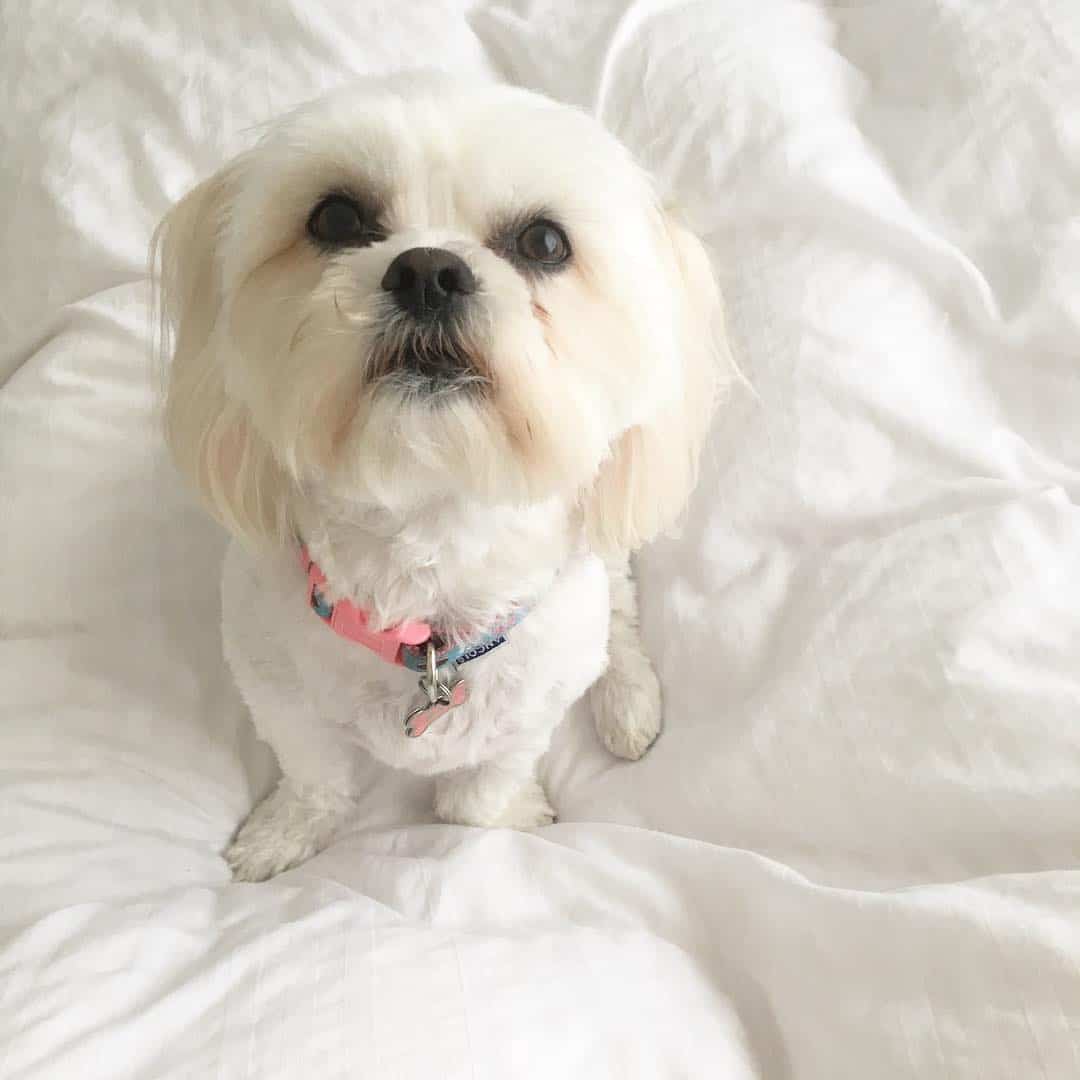
Photo from: @christine_maya
White Shih Tzus, just like black ones, come in solid white, and they don’t have any other color. Also, their nose has to be black. If a white Shih Tzu has a brown nose, he is considered a liver Shih Tzu instead of a white one.
Also, most kennel clubs don’t have some light color variations listed as a registration possibility. If you have a dog that is cream, for example, you’ll probably have to register him as a white Shih Tzu, even though his color is a very light peach color.
Things like this can make understanding Shih Tzu colors rather difficult.
Red Shih Tzu
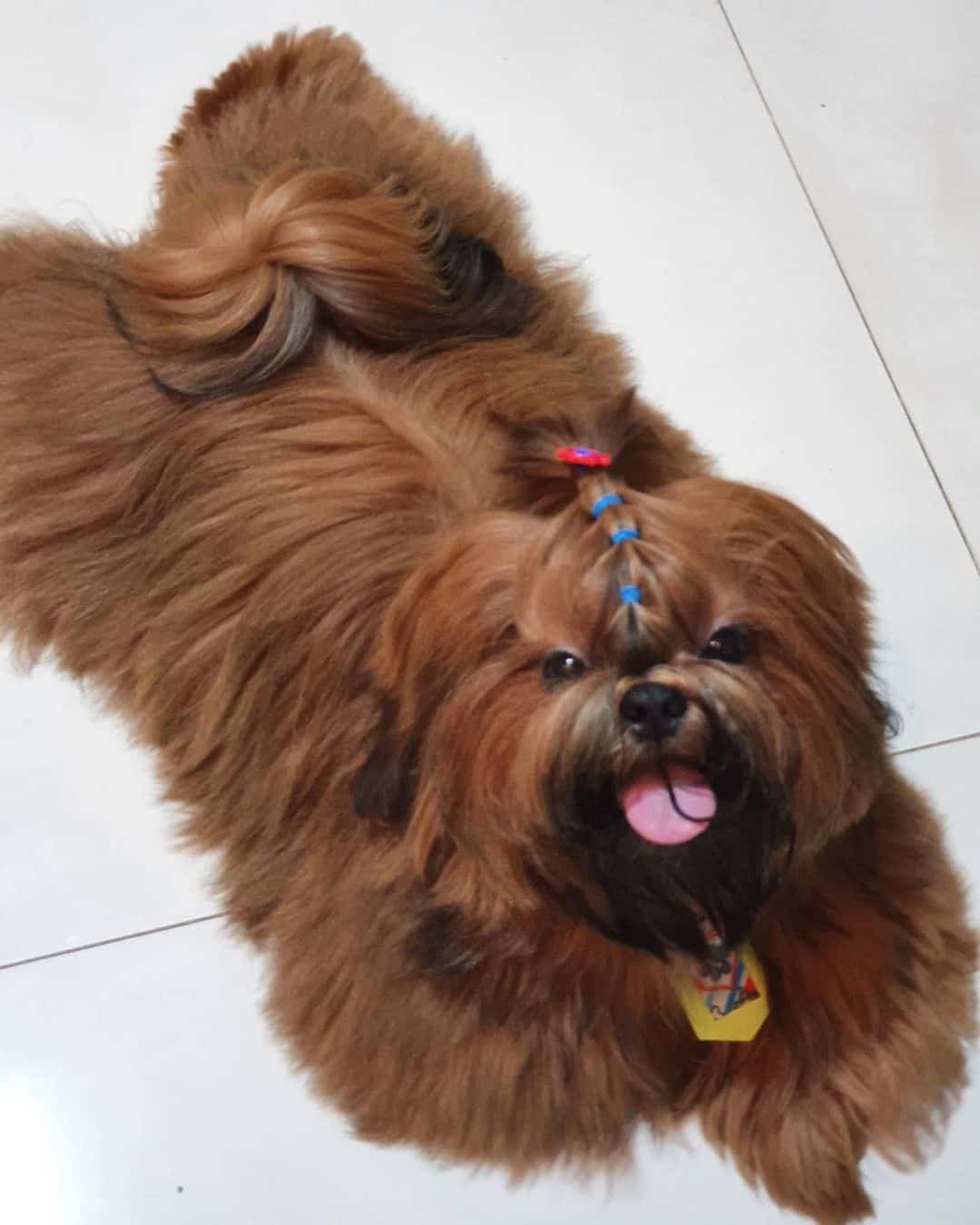
Photo from: @chewie.shihtzu
Red Shih Tzus have a coat that looks dark orange. Some might even look brown, but you will be able to notice a reddish shine under certain light.
Similar to a silver Shih Tzu, the red Shih Tzu will also have a black nose. This is the main way of differentiating a red from a liver Shih Tzu.
Gold Shih Tzu
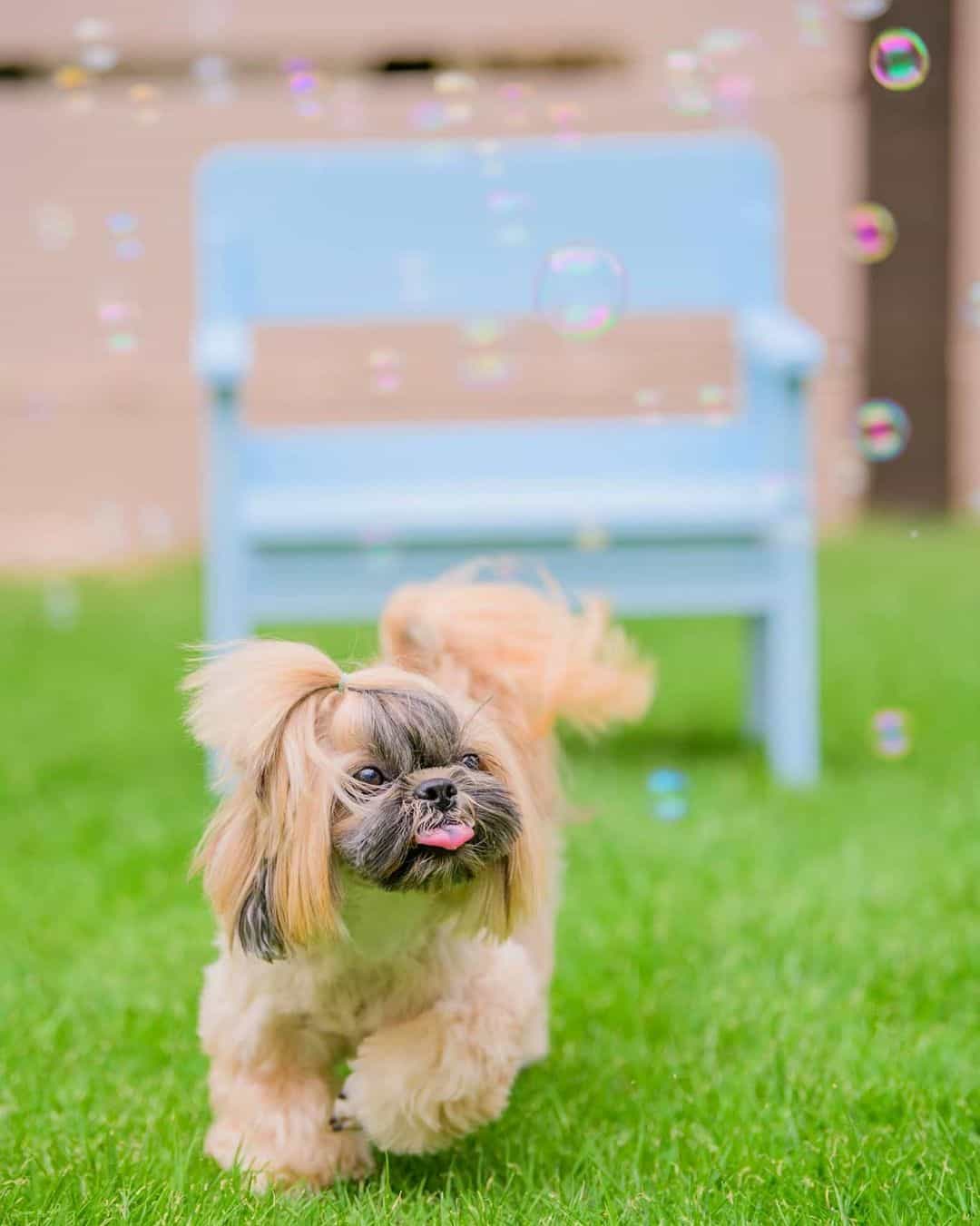
Photo from: @alicoslife
These dogs have a coat that may look similar to a tan or yellow one, but you can notice the shine on their fur that makes them different from other colors.
The shade of the coat might be anywhere between dark cream, light tan, or deep gold.
Keep in mind that most gold Shih Tzus will have some markings on them. Most of the time, this will be a black mask; however, this isn’t mandatory.
Brindle Shih Tzu
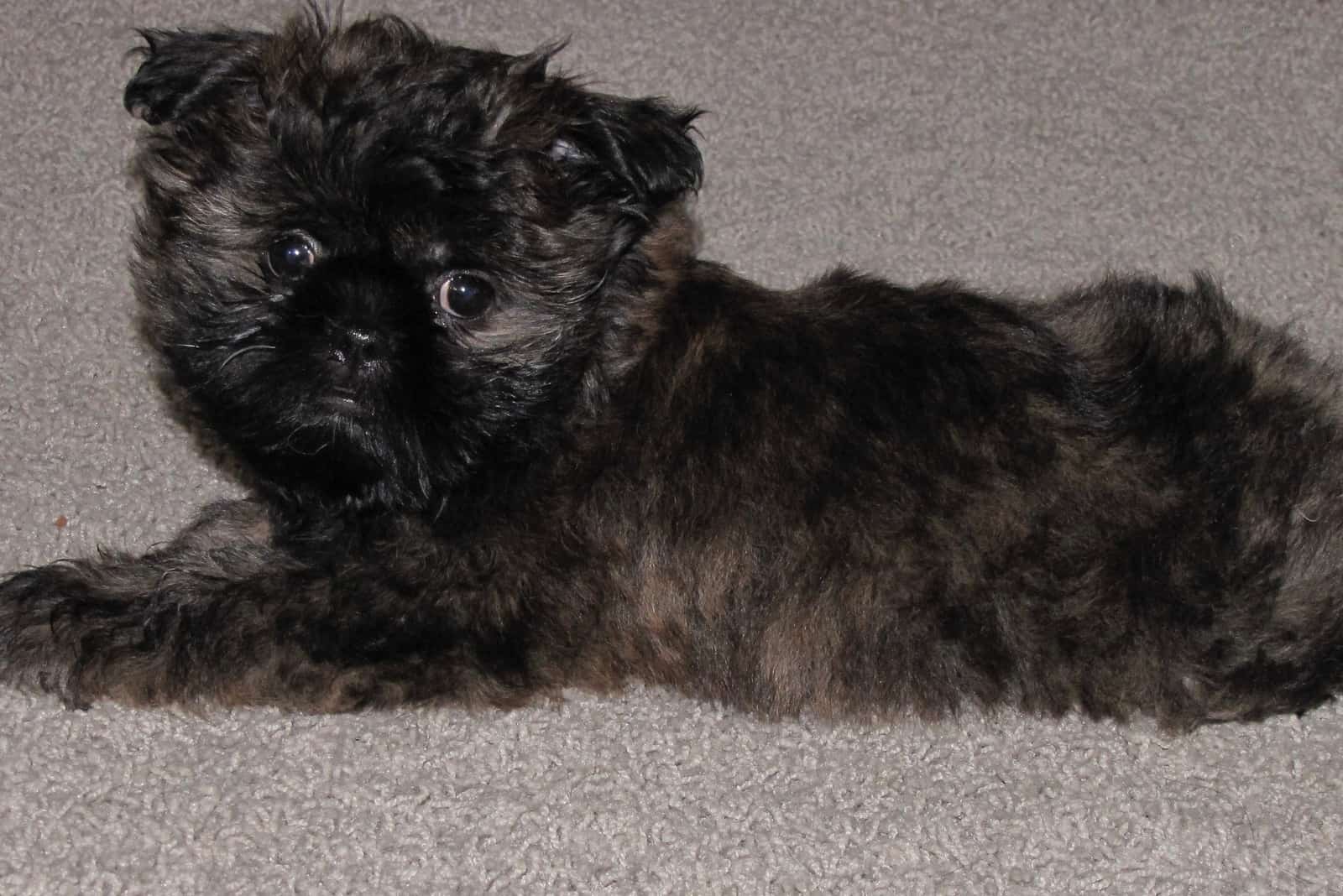
As mentioned before, brindle is actually a pattern. It is a combination of one color and stripes of some other, darker color. For example, you might have a silver Shih Tzu with black stripes.
There are no two brindle Shih Tzus that are the same. Each pup will have a different pattern, and the width of the stripes can also vary. Many Shih Tzus won’t even have their entire coat in brindle, but only parts of it.
The base coat color determines how you’ll be able to register your dog. For example, a blue brindle Shih Tzu will be registered as blue.
Also, while the stripes can come in several colors, a true brindle Shih Tzu will always have black points.
What complicates things a bit is that you may have a brindle Shih Tzu puppy that won’t be brindle when he grows up. Even if he stays brindle, the exact shade will most likely vary and look like something entirely different.
Brindle is a recessive gene, but even this isn’t so simple. For a brindle coat to be visible, there has to be a complex reaction to several genes, all of which are located on different parts of the gene.
Sable Shih Tzus
Just like brindle, sable isn’t really a coat color but rather a pattern. These dogs can have a base coat of any color, but their hairs will always have black tips. This will make them appear darker than they really are.
Silver Shih Tzus can come with a sable pattern, although this is rare. Also, due to the texture of the Shih Tzu’s coat, many Shih Tzu owners won’t even realize their doggie has a sable coat until the groomer tells them so during a hair cut.
Liver Shih Tzu
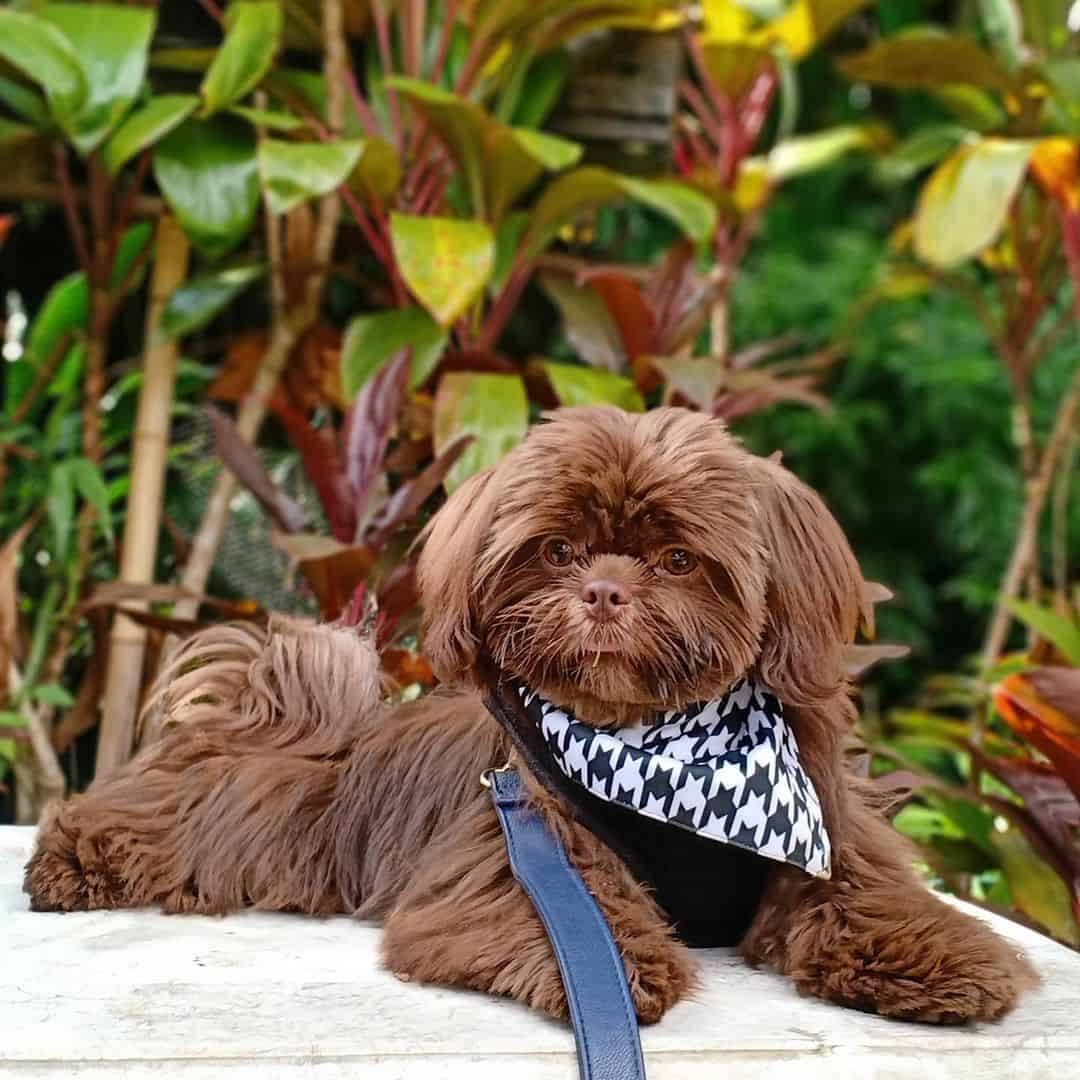
Photo from: @cappuccino.chocoshihtzu
Liver is one of those colors that is tricky to locate. This is because liver Shih Tzus are determined not by their coat color but by the color of their skin.
In other words, if a Shih Tzu has a brown nose, foot pads, and eye rims, he can be considered a liver Shih Tzu, no matter his coat color.
The reason behind this is that liver Shih Tzus don’t have a gene that carries black pigmentation. This is why there cannot be any black points on these dogs.
However, this doesn’t mean they cannot come in any other color than liver. While most of the time, these dogs will come in some brown shade – or liver-colored – they can be very light or very dark, or something in between. In fact, there are some liver Shih Tzus with a cream coat color or even white!
While very rare, some silver Shih Tzus might even be considered liver if their noses are brown. However, since silver is caused by the Chinchilla gene that causes dilution of the black coat color, this is unlikely to happen. These dogs will usually have at least a bit of a gold tint.
Another rare trait that may occur with liver Shih Tzus is green eyes. This doesn’t mean that the dog is a crossbreed. It’s simply rare.
Blue Shih Tzu
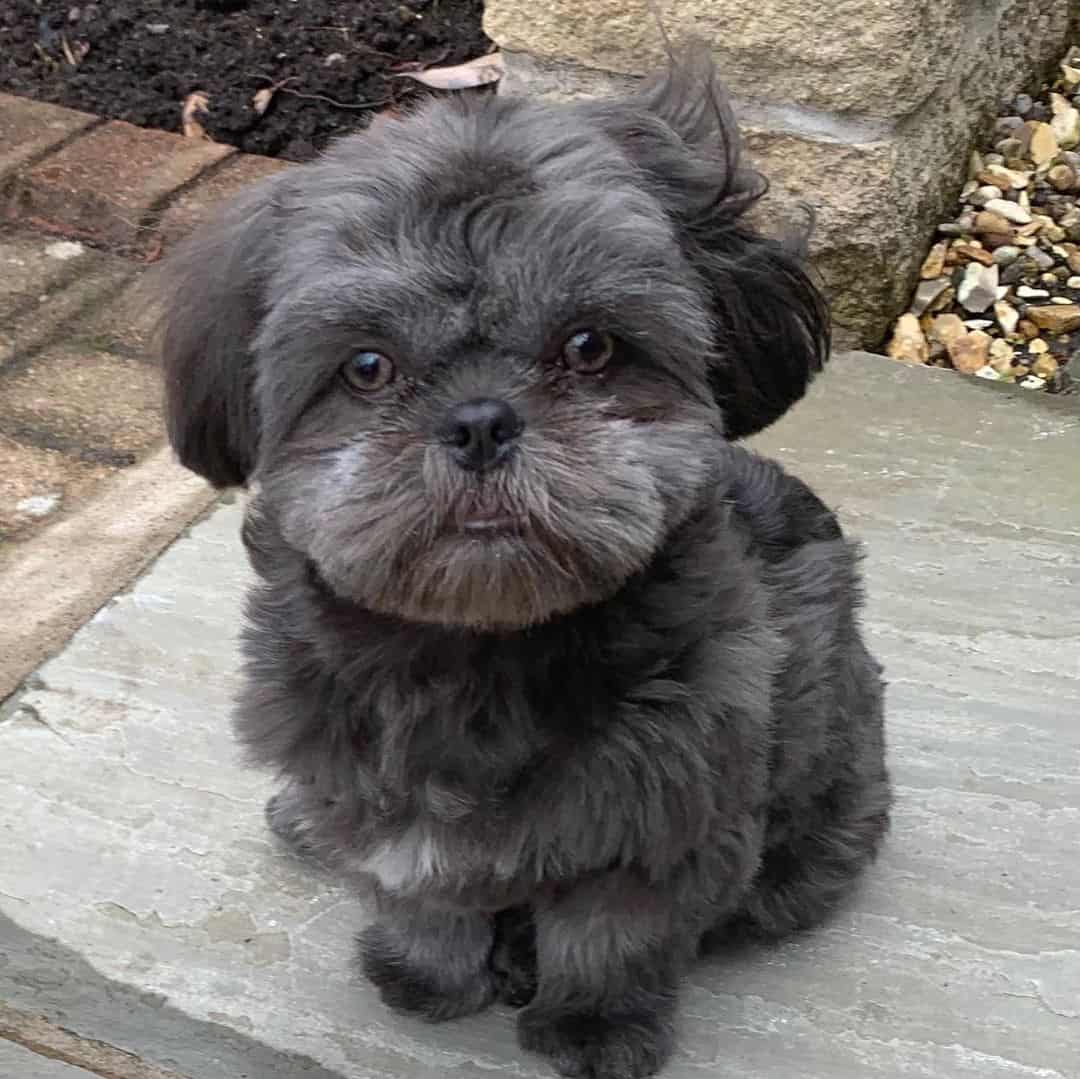
Photo from: @ozzyosbourne_blueshihtzu
Just like liver, blue dogs are determined by the color of their skin instead of the coat color. You can notice a blue Shih Tzu by it having a blue or grey nose instead of black or brown. However, its coat color can be very different.
Most blue Shih Tzus will look similar to grey or silver Shih Tzus. However, if you look at their noses and see that they aren’t black, this means that these are blue Shih Tzus with a silver coat color.
In fact, finding true blue Shih Tzus with a blue coat can be a bit challenging. This is because of the color change that happens in this dog breed. Many blue dogs will turn grey as they grow older, and there is no way you can predict this before it actually happens.
The blue color is the result of a dilute gene. It occurs when the gene affects the main color – usually black, but sometimes brown – and causes the pigment to be distributed irregularly. This is what causes the unique color of both the skin and the coat.
When this dilution gene affects the black pigment, you’ll get the blue color these dogs are known for. However, if the base coat color is brown, these dogs will be a light silvery color that you may know as lilac or Isabella. Another name for this unique shade is lavender.
Keep in mind that all of these dogs will be registered as blue Shih Tzus. This is because the AKC doesn’t list all colors, as we’ve already mentioned.
Also, this dilution gene doesn’t necessarily have to affect the dog’s coat color. However, the skin – most notably, the nose – will always be affected.
Liver And White Shih Tzus
Liver and white Shih Tzus come with a liver base coat, but they also have white markings on their bodies. Also, all liver and white Shih Tzus will have brown noses, as the dilution gene necessarily affects the dog’s skin.
Red And White Shih Tzus
Red and white Shih Tzus have a base coat of some shade of red interrupted with white markings.
The red shade can vary anywhere from mahogany to bright orange. It might even look tan. However, you’ll know these dogs aren’t liver because of their black nose and dark eyes.
Black And White Shih Tzus
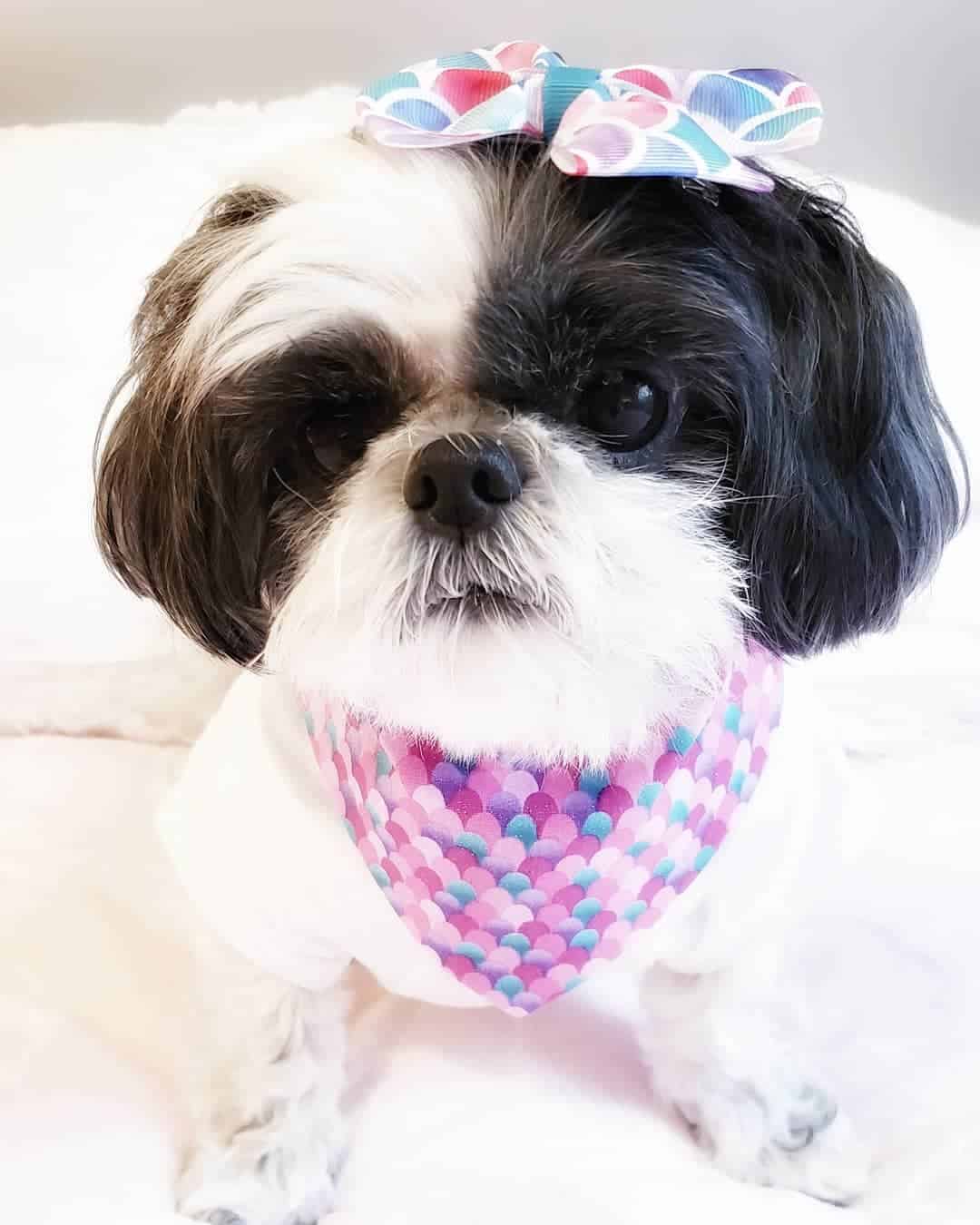
Photo from: @maisytzu
This is one of the Shih Tzu colors that goes through the least change over time. Still, some black and white dogs might become silver and white.
These pups have a black base coat with white markings. Also, they have a black nose and dark eye color.
It’s important to note that some black and white Shih Tzus might be born with a pink nose. However, after they are a few weeks old, their noses should turn black once the pigment forms.
Blue And White Shih Tzus
While not a common color pattern, blue and white Shih Tzus still exist, and they are considered one of the most unique dogs in the world. These dogs have a blue base coat with a white coat pattern.
The exact pattern can vary. You can have blue and white Shih Tzus in parti, tuxedo, or they might simply come with a white belly. Piebald dogs are also common.
Black Gold White Shih Tzus
This is one of the more common tricolor combinations in Shih Tzus. These dogs come in a wide variety of patterns, and it doesn’t really matter what their base color is.
While you might think these pups have tan markings, if you look closely, you might notice that the yellow parts of their fur have a shine to them, making them look shiny and regal.
Unique Shih Tzu Markings
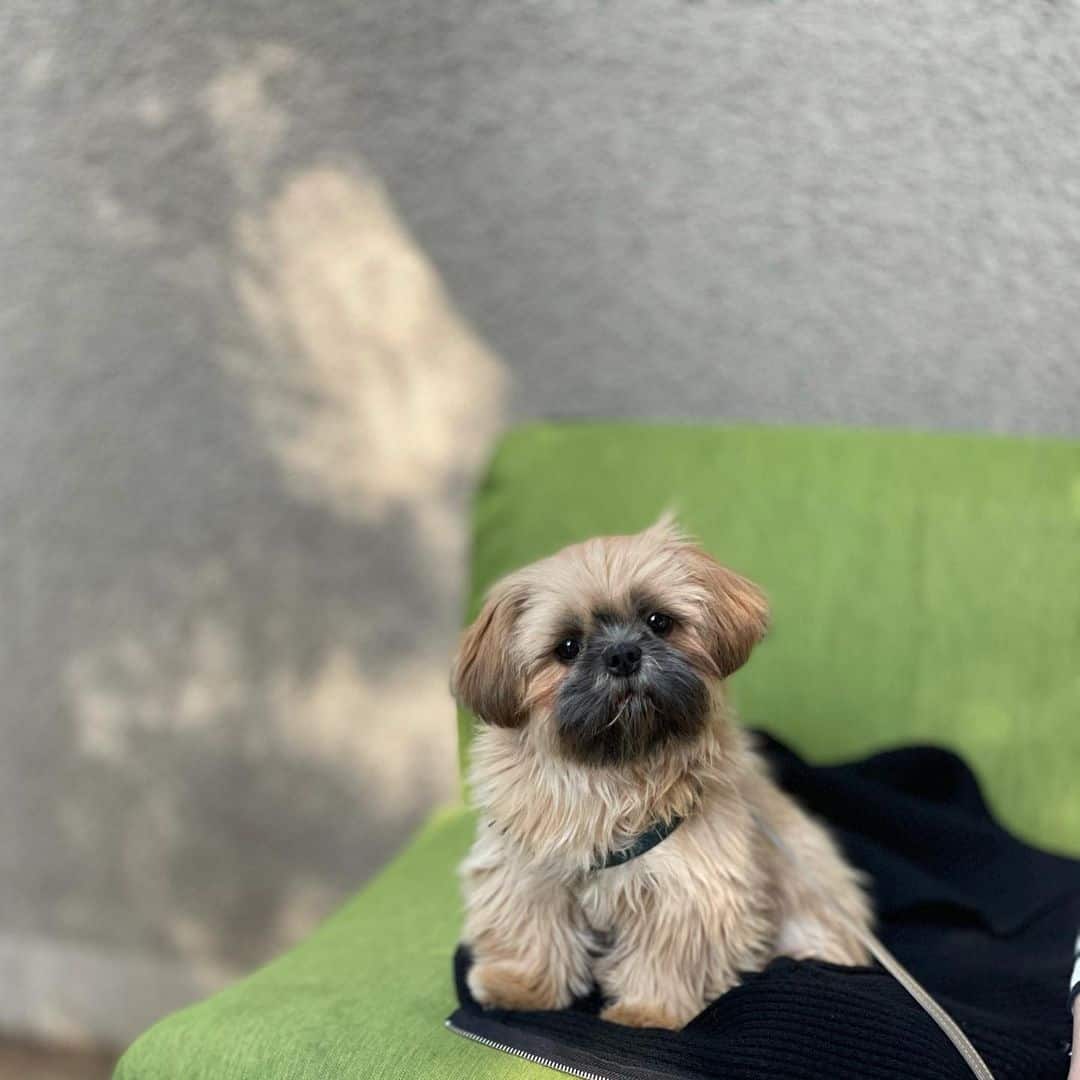
Photo from: @masato.oolong
Other than coat colors, these dogs can have many markings, some of which are unique to the Shih Tzu breed. Most of these markings can occur on a silver Shih Tzu, as well as on any other base color.
Black Mask
Did you notice that your Shih Tzu has a black muzzle? This pattern is called a black mask. Sometimes, this unique pattern can extend towards your dog’s eyes, ears, even up to his forehead!
This pattern can occur on any coat color. However, it is pretty common on gold, white, red, or silver Shih Tzus.
Dobie Markings
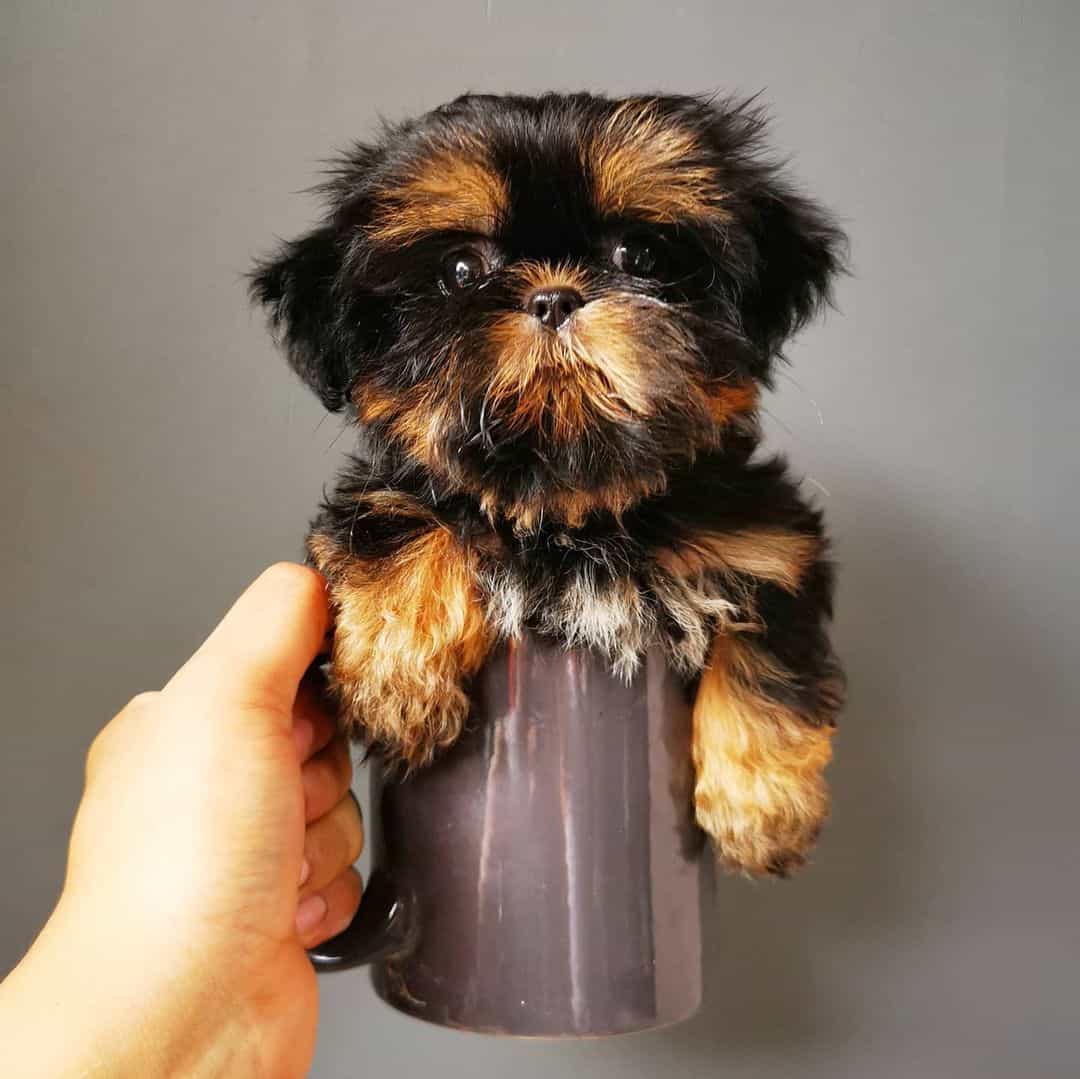
Photo from: @lawkwatsero
This is one of the rarest coat patterns in Shih Tzus. The Dobie markings occur on a dark, usually black base coat, and they are tan-colored. They are located above the eyes, on the jowls, under the tail, and on the hind legs.
If you’re having trouble visualizing this pattern, just think of Dobermans. Yes, the pattern got its name after this dog breed.
Shih Tzus with Dobie markings are considered premium dogs, and they are usually sold at a very high price. This is because the pattern is caused by a recessive gene, so both parents have to be the carriers.
Also, even if both parents have the genes for the Dobie pattern, this doesn’t necessarily mean that the Shih Tzu puppy will inherit it. The tan markings may be distributed in some other way, ruining the pattern.
Blaze
If you hear a breeder or another Shih Tzu owner mentioning how their dog has a blaze, you might wonder what that means.
A blaze is simply a unique pattern that can occur in the Shih Tzu breed. This is a strip of white hair located right in the center of the face, between the dog’s eyes. It’s common in all coat colors, including the silver Shih Tzu.
Flare
The flare is similar to blaze, but with a small difference: it’s wider, and it spreads towards the top of the skull instead of being narrow and limited to between the dog’s eyes.
Shawl
The shawl, or a collar, is the marking around a Shih Tzu’s neck. As its name suggests, it looks like a shawl that your dog carries over its shoulders.
Most of the time, this marking is white, but it can come in some other color.
Saddle
The saddle is a large patch of color (most of the time, it’s white) that goes on the dog’s back. It’s located where a horse’s saddle would go, hence the name.
Tuxedo
Tuxedo is a unique way in which white patterns are distributed. Overall, dogs with this pattern have a white patch of hair on their chest, chin, and sometimes on their feet. This makes them look like they’re wearing a tuxedo!
How To Choose A Shih Tzu Color
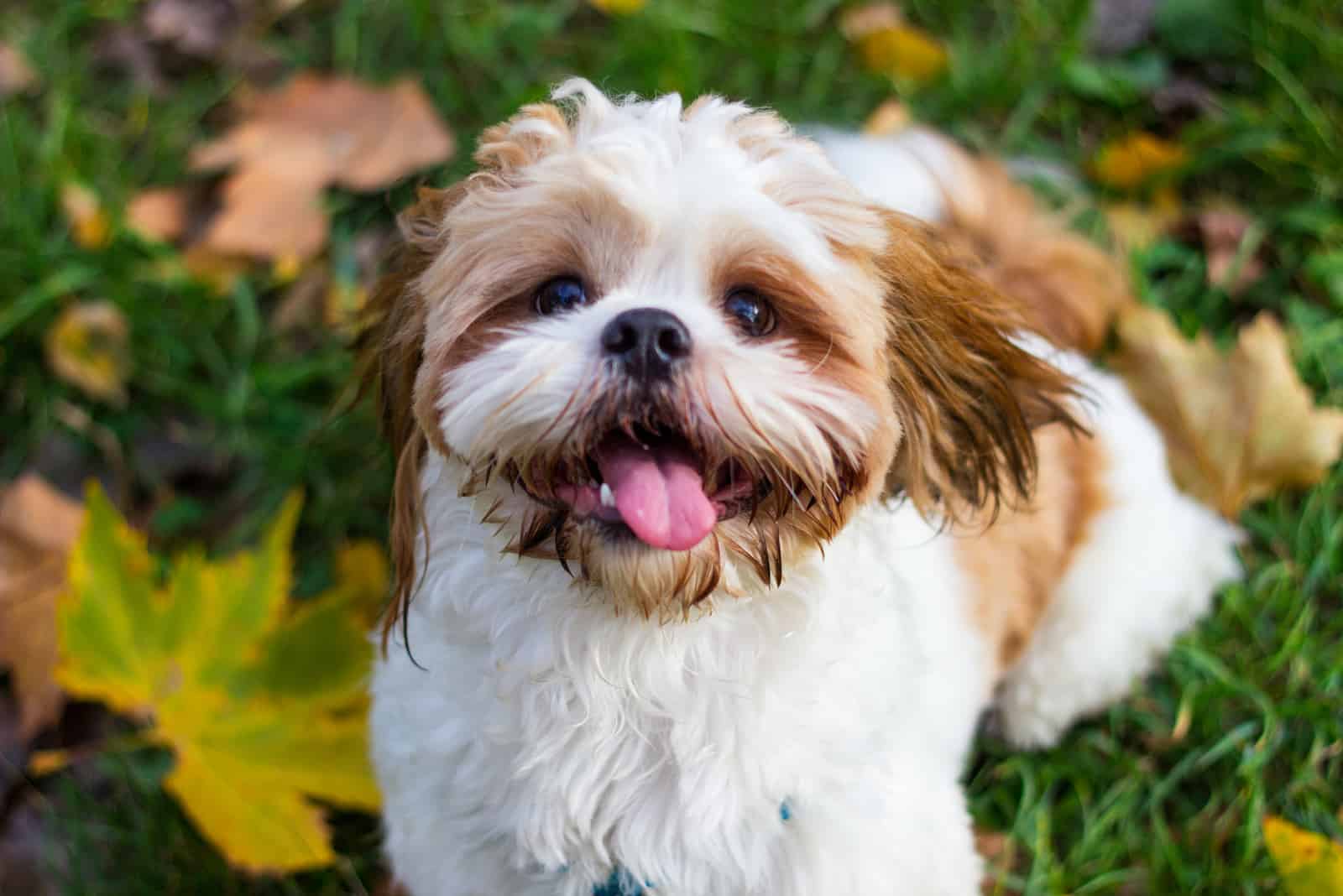
So, how can you know which Shih Tzu color is the best for you? Do you like silver Shih Tzus, or is maybe some other color your preference? Here are a few things you need to consider:
• A dog with a light coat will require more bathing and overall grooming.
• If your dog has a white color around the muzzle, on his eyes, or anywhere on his face, he might get stained easily.
• Some coat colors, such as chocolate, albino, or merle, have been connected with health problems. This is why kennel clubs don’t accept these coat colors and patterns.
• Some rare colors can be quite expensive.
Should You Buy A Silver Shih Tzu?
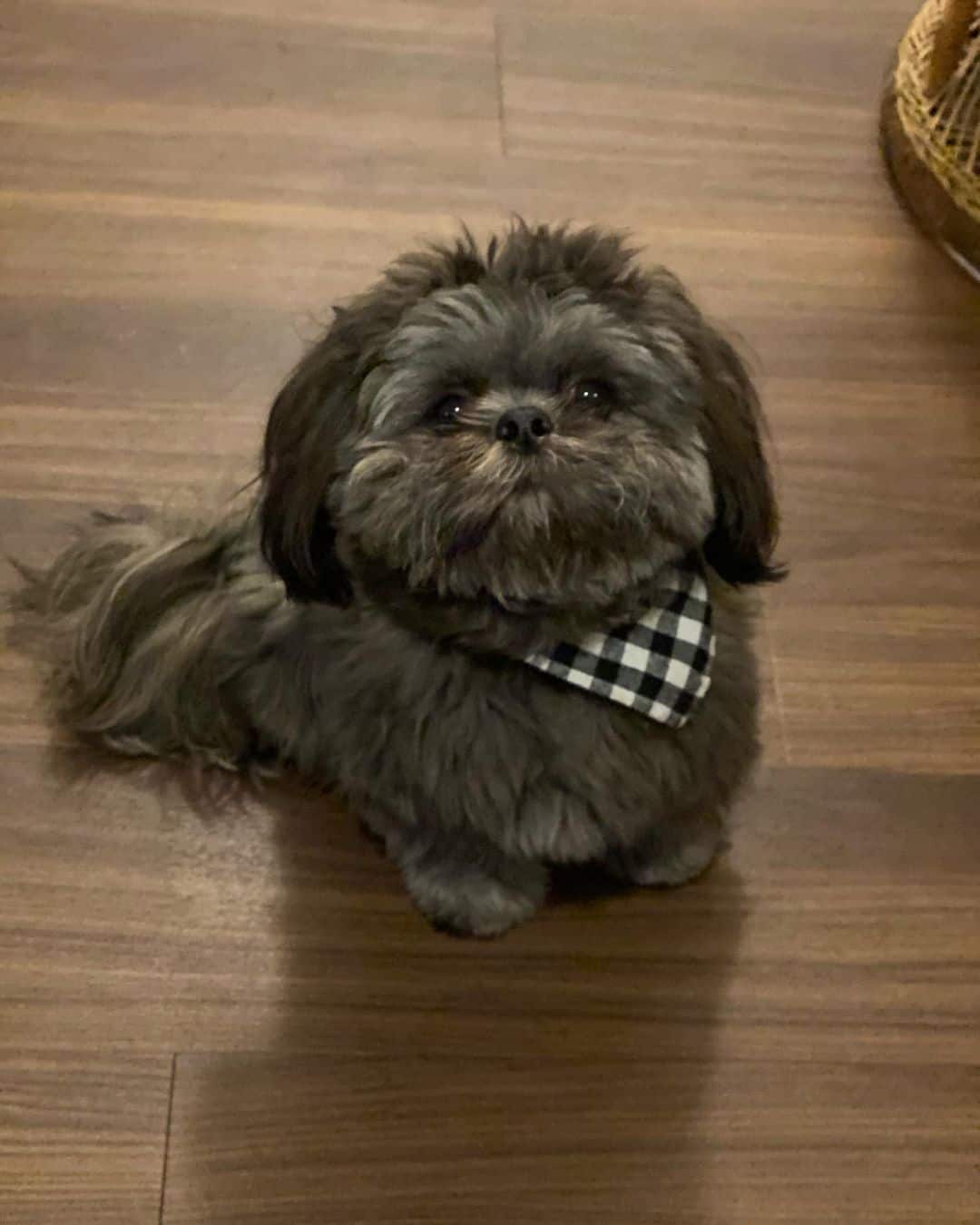
Photo from: @dopelifeofjax
There are many reasons silver Shih Tzus are so loved among dog owners. This is a unique color that, unlike grey, won’t make your pup look old, but it will still stand out from the rest.
Also, since silver is a shiny color, your dog will look pristine, clean, and royal after just a little bit of grooming. This makes him look like a million dollars, even though you’ve only invested in a bristle brush and maybe one visit to the groomer!
Also, unlike some coat colors, silver Shih Tzus don’t have higher chances of developing some health conditions, making them a perfectly healthy choice – as long as you’re buying them from a reputable breeder.
It’s important to keep in mind, though, that coat color is less important than some other factors. Overall, all Shih Tzus make amazing family pets, as they are affectionate, loyal, and loving. No matter their fur color, they’ll stay by your side no matter what!
Besides, choosing a Shih Tzu color isn’t really the most thankful thing you can do. You may buy a dog that looks a certain way, just to end up with an adult dog in a whole different color!
This is why you shouldn’t really choose a dog by its coat color. Instead, look for a playful, healthy dog that will stay your best friend for as long as possible.
